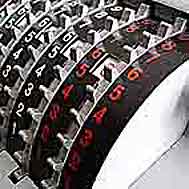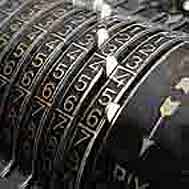The input devices
The stylus setting
The input device of the Schickard and Pascal calculators are circular dials. To register a figure on one of the decimal orders, a style is introduced at a proper position into the dial which is rotated from 1 to 9 tenth of turn. The input dial is in direct catch with the accumulator.
This system was used on the adding machines with cogged slide bars of Kummer. To addition, the operator introduces the style in the hole facing the figure to be add and moves it towards the zero thrust. Some mechanisms make it possible to substract by moving the style in opposite direction.
Stylus on circular dial

Stylus in slides

Stylus in chains

Other calculating machines use the same principle making it possible to actuate directly with a finger the moving part of the mechanism.
The stylus is replaced by a finger

The setting levers
The first progress have appeared with levers or cursors input. To register a figure it is enough to place a lever (cursor) on the figure to be registered.
One of the advantages is that the inscriptor is not in direct catch with the driving mechanism. A number is introduced with the levers and remains available as long as the levers are not displaced. Thus, to multiply a number by n it is enough to register it only once and to turn n times the cranck.
levers on circular slides

levers in linear slides

The keyboard setting
The following improvement was the keyboard setting. The registration of a figure is done by depression of a key. the input of a number is done in a very short time and asks less attention from the operator compared to the lever input system.
The keyboards can be classified in 3 categories, the full keyboard, the condensed keyboard and the half keyboard.
The full keyboard
A keyboard is said "full" when it has a set of 9 keys for each order of decimal units . The first full keyboard machine has been developed by American Felt in 1885. This adding machine marketed under the name of "Comptometer" can subtract by using the the nine complements method. One of the advantages of these machines is that it is possible to simultaneously register several figures of a number by using the 5 fingers of the hand.
in the case of the full keyboard adding machines like the ' Comptometer', a technical difficulty has to be solved. The fact of being able to enter at the same time several digits of a number requires to be able to perform a carry on a wheel which is moving. It is necessary in this case to give to this wheel a relative profit of a tooth.

The condensed keyboard
A condensed keyboard has only 10 keys (0 to 9). To register a number, the operator must sequentially depress the keys in the reading order of the figures the number is composed. All these machines are provided with a device called distributor charged to distribute the various figures in the successive decimal orders.

The half keyboard
Some adding machines were marketed with a keyboard reduced to a set of 5 keys (1 to 5) for each decimal order. The counterpart oh this economy is that a double keying is needed to register a figure from 6 to 9 (figure 7 requires for example to strike successively keys 5 and 2)

The first 2 types of keyboards were competed each other until the end of the manufacture of the mechanical calculating machines without one taking the advantage on the other.